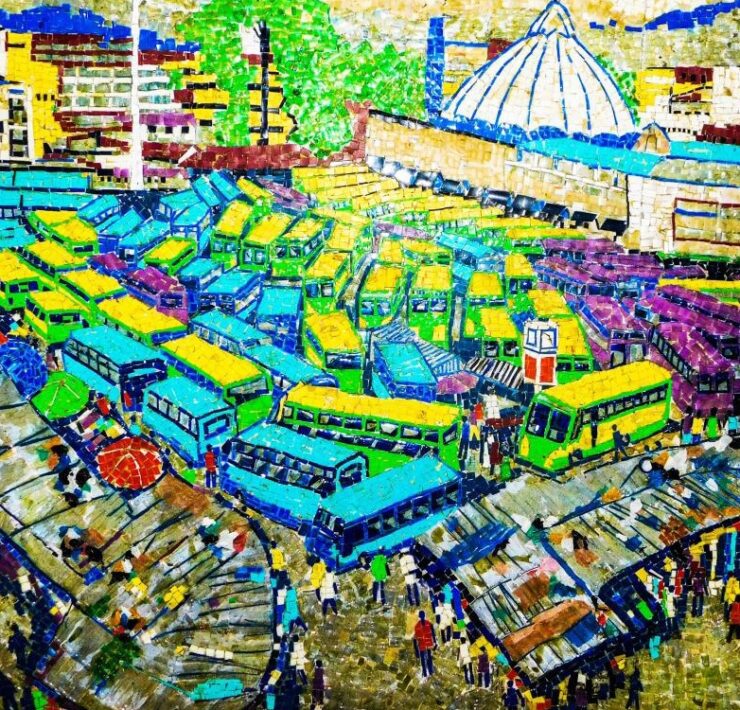
Mr. Wanyama Ogutu is a scholar in the Master of…
One chilly morning, a gentle tap landed on my shoulder, and what followed was a hilarious simile from an old woman sitting next to me on an engraved wooden pie. I was following an intense communion service, and my thoughts were sinking into a liturgy book of prayer. Her storytelling on the sparkle of the enigmatic rose window left me snooping about the mysterious iconography of the art form. She acclaims that the “rose window” diverts her attention from a controversial socio-political sermon to the coming of the so called Savior of entire world. She deduced that the position and the glitter of the rose window are expressions in fulfilment of the prophetic voice of a bachelor man, who refused to get married and lived alone in the desert of the sub-Saharan valley, dinning on insects and snakes. She continued to narrate a story of a notable astronomical from the east side and the dramatic events of uncircumcised men worshiping a poor baby who was born along the local trading center.
I decided to be more observant during the whole service and noticed that the rose window drew attention to the congregants who were worshipping while kneeling and sitting on the wooden pier. I also realized that the rose window is located in a strategically high position opposite the main cathedral door. It’s amazing how it takes advantage of the rising sun to glitter with beautiful colors. The next time I attended the ceremonial communion service, I watched the archbishop, together with his contingents of canons, clergy, lay readers, and choirs, marching like African Colonial Riffles with their heads up and looking at the sparkle of the rose window.
 PIN IT
PIN ITThe glittering rose window at All Saints Cathedral, Nairobi, takes the circular shape of a wheel on a bicycle, with an intensively decorated Afrikan floral design. The geometrical shapes are arranged in a rhythmic pattern to suggest movement, exhibiting various color harmonies in the color wheel. As the sun rises from the east, the rose window glitters and displays attractive complementary, primary, and secondary color harmonies. With a look at the rose window, you can acknowledge that African artists designed the rose window to present the story of a shining star in Bethlehem surrounded by a crown of thorns and the cross of Jesus Christ. The cross is streamed out with complementary color harmonies of dark blue. The supposition of stars created a radial, asymmetrical balance that subdued the surmounting cool color. The radial balance has formed a rhythmic pattern of intrinsically colored shapes radiating a warm color against a cool color. This design on the rose window represents Jesus Christ’s resurrection and the return of Jesus Christ in the last days.
The design of the rose window at All Saints Cathedral, Nairobi, bears a resemblance to his mother church in Kent, England. The rose window spread from other European cathedrals, such as France and the United Kingdom, to other continents, including early missionaries’ churches in Africa. In Kenya, Euro-centric mainstream churches such as the Roman Catholic, Anglican, Presbyterian, and Methodist, among others, value the art of the rose window. However, upcoming evangelical churches consider the minimalist art of the rose window in their architectural designs. The consequences might be due to the de-escalating influence of professional artists and designers, the obliviousness of religious leaders, and the abandonment of symbolism in some Christian doctrines.
Aside from the biblical origin of the rose window according to the gospel of Saint Matthew, it also has a historical origin in Saint Catherine of Alexandria, who was executed beneath the spike of a horse chariot wheel regarding her unapologetic faith in Christ. The Catherine Window, which was designed with the intense spikes of a horse chariot, became a memorial martyr to Saint Catherine in all gothic cathedrals throughout Europe, Asia, and America. However, due to the rise in dissimilarity in faith among various Christian doctrines, Catherine’s Window was renamed the Rose Window, and it now incorporates symbolic floral designs depicting bible themes. It is important to recognize that in 1994, the former chief graphic designer of the Kenya Institute of Education (KIE), Mr. William Esikhaty, conceptualized the rose window at All Saints Cathedral, Nairobi, into the current cooperative identity. Esikhaty drew and designed an inspiration for it, and, later, his Asian friend redesigned and reproduced the drawing into a computer-aided version. Currently, the computer-designed version of the Rose Window is adopted as an official logo, landmark, trademark, and emblem, among other things, at All Saints Cathedral, Nairobi.
 PIN IT
PIN ITIn conclusion, the gleaming rose window captures the attention of members of the public during the church service at All Saints Cathedral, Nairobi. It displays intrinsically beautiful color harmonies that give a reverence for worship and a reflection of the star in the city of Bethlehem. In the cathedral age, the Rose Window was given various historical names such as Wheel Window and Catherine Window. The Rose Window at All Saints Cathedral, Nairobi, has been inspired to utilize an official cooperative identity.
REFERENCE
Ogutu W. (2020).The Restitution of Indigenous Religious Artifacts: The Case of Study All
Saints’ Cathedral, Nairobi- Kenya–International Journal of Innovative Science and Research
Technology Vol 5.(6)
Vikiru, G., Aguda, B,. Muneza,D,. Abati, I., &. Ogutu, W. (2021). Evolution of trends and processes in Artistic practice in Africa. Design for All Institute of India Vol(16),5
Rev Mawiyoo. 2018. Growing Church: Centenary Celebration. All Saints Cathedral, Nairobi, New & Views
Subscribe now for updates from Msingi Afrika Magazine!
Receive notifications about new issues, products and offers.
What's Your Reaction?
 PIN IT
PIN ITMr. Wanyama Ogutu is a scholar in the Master of Arts (Fine Arts) program at Kenyatta University. He is also a practicing visual artist specializing in drawing, painting, and sculpture within, Nairobi, Kenya. He focusing in Painting with its’ philosophy, education and extension to Africa contemporary Art. Most of his artworks focus on interaction, environment, and education. Wanyama has a passion for fine art research; its philosophy, development, and relevance. He writes on profound academic topics, where he has presented and published in international journals and conferences around the world. He is a consultant in innovation and creative strategy on issues affecting our society. He is currently a part-time teacher at some TVET institutes within Nairobi.





















